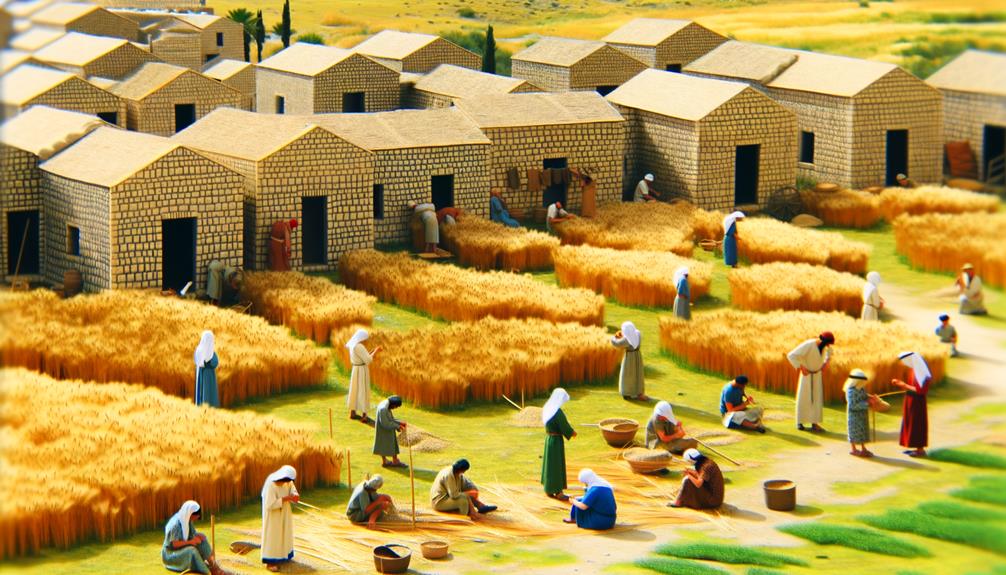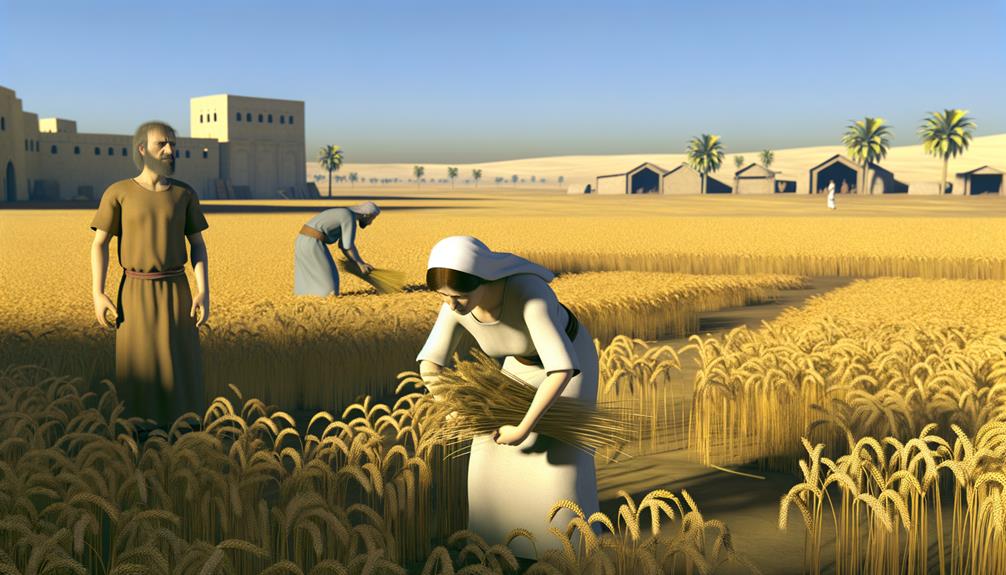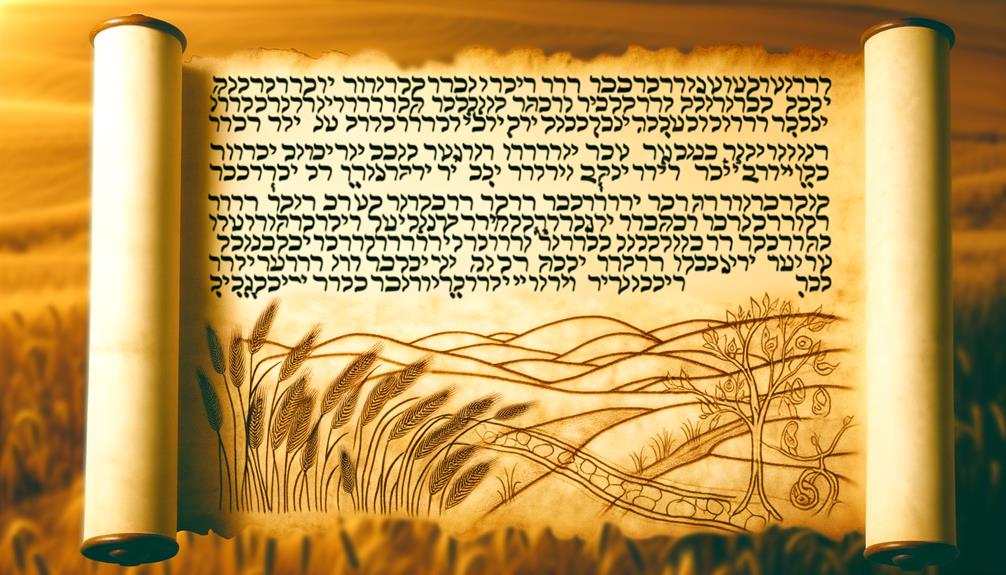Bible Book of Ruth Meaning: Loyalty and Redemption
The Book of Ruth, set in the tumultuous period of the Judges, underscores themes of loyalty, divine providence, social justice, and familial duty. Ruth, a Moabite widow, embodies unwavering devotion to her mother-in-law Naomi, manifesting profound loyalty and resilience.
The narrative also introduces Boaz, the kinsman-redeemer, whose actions highlight societal customs and integrity. Through its chiastic literary structure, the book emphasizes the restoration of Naomi’s family line, aligning personal loyalty with broader divine purposes.
These themes resonate with contemporary issues of community support and ethical responsibility, offering deeper insights into the enduring relevance of this ancient text.

The Meaning of the Book of Ruth: Lessons of Loyalty, Faithfulness, and Redemption in the Bible
| Aspect | Biblical Meaning | Scriptural Significance |
|---|---|---|
| Loyalty and Devotion | Ruth’s unwavering loyalty to her mother-in-law, Naomi, even after her husband’s death, is a central theme in the Book of Ruth. Ruth’s famous words, “Where you go, I will go,” reflect deep devotion and commitment. | In Ruth 1:16, Ruth’s loyalty represents a selfless love and devotion to both Naomi and God, embodying the importance of family and faith. |
| Faithfulness to God | The Book of Ruth demonstrates faithfulness not only to people but also to God. Ruth, a Moabite woman, commits herself to Naomi’s God, choosing faith in the God of Israel over her own people’s gods. | Ruth’s conversion and faith in God are key examples of inclusiveness in God’s plan, showing that anyone can be part of God’s covenant community through faith. |
| Kindness and Compassion | The story highlights the power of kindness and compassion through the characters of Ruth, Naomi, and Boaz. Each act of kindness plays a pivotal role in bringing about redemption and blessings. | Boaz’s kindness toward Ruth in Ruth 2:11-12 shows God’s compassion at work through human relationships, demonstrating the value of loving others. |
| Redemption and God’s Providence | The central theme of redemption is embodied by Boaz, who redeems Ruth and Naomi’s family by marrying Ruth. This act reflects God’s redemptive love and His providence in bringing hope out of loss. | Boaz’s role as the “kinsman-redeemer” in Ruth 4 symbolizes God’s provision for the broken and the way He brings restoration, foreshadowing Christ’s redemption of humanity. |
| Hope Amid Adversity | Ruth and Naomi experience severe loss and hardship, yet their story is one of hope, showing how God works through trials to bring about His plan and blessing. | This story illustrates that even in moments of deep despair, God’s providence is at work, guiding and shaping events for ultimate good. |
| God’s Inclusive Plan | Ruth, a non-Israelite, becomes part of the lineage of King David and, ultimately, Jesus Christ. Her inclusion in God’s plan demonstrates that God’s love and redemption are open to all people, regardless of background. | Ruth’s inclusion in the genealogy of Christ (Matthew 1:5) shows the inclusiveness of God’s kingdom, breaking cultural and ethnic barriers. |
| Strength of Character | Ruth is a model of strength, diligence, and humility. Despite her difficult circumstances, she works hard to provide for Naomi and is recognized for her noble character by Boaz. | Ruth’s strength and perseverance in Ruth 2 serve as an example of godly character and integrity, reminding believers to live with honor even in hardship. |
| The Power of Covenant Relationships | The deep bond between Ruth and Naomi reflects the power of covenant relationships and the blessings that flow from loyalty and trust in God’s plan. | The Book of Ruth exemplifies how covenant relationships between people can reflect God’s covenant with humanity. |
Historical Context

The historical context of the Book of Ruth is set during the period of the Judges, a time characterized by social instability and religious fluctuation in ancient Israel. This era, spanning roughly from the 12th to the 11th century BCE, was marked by decentralized governance and cyclical patterns of apostasy, oppression, and deliverance.
The absence of a unified leadership led to frequent conflicts and a fragmented society struggling to maintain its covenantal identity. The narrative of Ruth unfolds against this backdrop, emphasizing themes of loyalty, kinship, and divine providence.
Key Characters

Central to the narrative of the Book of Ruth are several pivotal characters, each embodying distinct virtues and roles that drive the story’s themes of loyalty, redemption, and divine orchestration.
Ruth, the Moabite widow, exemplifies unwavering loyalty and faith.
Her mother-in-law, Naomi, represents resilience and transformation through hardship.
Boaz, a relative of Naomi, embodies integrity and the role of the kinsman-redeemer, illustrating societal and legal customs of the time.
These characters are intricately woven into the narrative, providing a rich tapestry of interpersonal relationships and divine providence.
- Ruth: Moabite widow who displays unwavering loyalty and faith.
- Naomi: Mother-in-law of Ruth, symbolizing resilience and transformation.
Major Themes

Exploring the major themes of the Book of Ruth reveals profound insights into loyalty, divine providence, and social justice within the context of ancient Israelite society. Ruth’s unwavering loyalty to Naomi exemplifies the depth of familial commitment and selflessness. Divine providence is illustrated through God’s subtle guidance, ensuring the survival and well-being of Ruth and Naomi. Additionally, the narrative touches on social justice, particularly in the treatment of widows and foreigners, showcasing the importance of community responsibility.
| Theme | Description | Illustration |
|---|---|---|
| Loyalty | Ruth’s devotion to Naomi | Ruth 1:16-17 |
| Divine Providence | God’s unseen hand guiding events | Ruth 2:3 |
| Social Justice | Protection and provision for the vulnerable | Ruth 2:8-9 |
| Familial Duty | Boaz’s role as kinsman-redeemer | Ruth 4:1-10 |
| Redemption | Restoration of Naomi’s family line | Ruth 4:13-17 |
Literary Structure

Understanding the literary structure of the Book of Ruth reveals its meticulous composition and thematic coherence, which enhances the narrative’s impact and depth. This short yet profound text is divided into four distinct chapters, each contributing to the overarching story of loyalty, providence, and redemption. The narrative is framed by a chiastic structure, a common biblical literary device that emphasizes central themes through mirrored elements.
- Chapter 1: Introduction to Ruth and Naomi’s plight, setting the stage for the subsequent narrative.
- Chapter 2-3: Development of Ruth’s relationship with Boaz, highlighting themes of kindness and loyalty.
This structural precision underscores the text’s theological and literary richness.
Modern-Day Relevance

The enduring relevance of the Book of Ruth in contemporary society is evident through its exploration of themes such as loyalty, resilience, and community support, which continue to resonate across diverse cultural and social contexts.
Ruth’s unwavering loyalty to Naomi exemplifies steadfast relational bonds, a principle that underpins modern social cohesion.
Her resilience in facing adversity echoes the challenges individuals encounter today, highlighting the timeless nature of human perseverance.
Additionally, the narrative emphasizes community support, as seen in Boaz’s generosity, which mirrors current social practices of aiding marginalized groups.
These themes collectively underscore the Book of Ruth’s capacity to provide moral and ethical guidance, fostering a deeper understanding of communal responsibility and personal integrity in today’s world.
Conclusion
The Book of Ruth, akin to a finely woven tapestry, interlaces historical context, pivotal characters, and profound themes into a cohesive narrative that transcends time.
Its literary structure, meticulously crafted, serves as a beacon illuminating the virtues of loyalty, love, and providence.
Modern readers, like wayfarers guided by an ancient map, find relevance in its enduring lessons, which continue to resonate through the corridors of contemporary life, offering timeless wisdom and solace.






